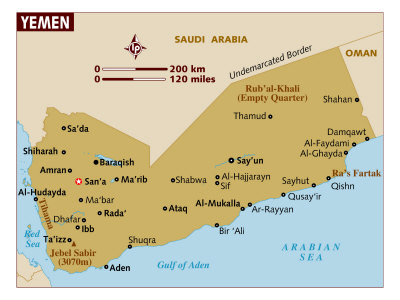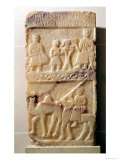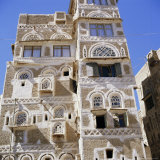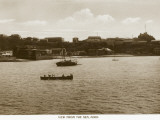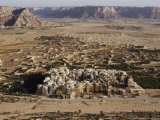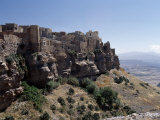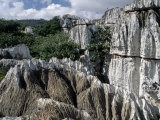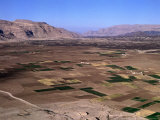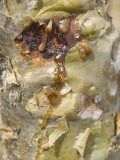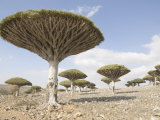|
|
Yemen and Yemeni Culture Posters, Art Prints, Charts, Maps
|
geography > Middle East > YEMEN < social studies
|
Yemen, one of the oldest centers of civilization in the Middle East, is located on the southwest tip of the Arabian Peninsula, immediately on the strait Bab el Mandeb, linking the Red Sea and the Gulf of Aden to the west and south, and the Arabian Sea (Indian Ocean) on the south. Land borders are with Oman on the east, and Saudi Arabia on the north.
Yemen is approximately twice the size of the State of Wyoming. Its terrain is a narrow coastal plain merges into flat-topped hills and rugged mountains, with a central upland desert plain connecting into the Arabian Peninsula desert interior. Yemen has seasonal monsoons in the western mountains, dust storms in the summers, and very limited fresh water supplies. The Red Sea coast is called the Tihamah (“hot lands / earth”), where the highland stream do not flow into the sea but contribute of ground water reserves and marsh areas.
Yemen's territory includes more than 200 islands; many are volcanic. The largest is Socotra, about 415 km to the south of mainland Yemen, off the coast of Somalia.
In 1990 North and South Yemen joined into the Republic of Yemen using Islamic, Turkish, English common and local tribal customary law. Yemenis have universal suffrage at age 18. Sana'a is the capital; other cities in Yemen include Aden, Marib (Sheba),
Yemen, one of the poorest countries in the Middle East, economy is based on oil production. Most people are employed in herding and agriculture. Yemen is diversifing by developing a tourism industry.
Yemen is considered a possible location of the kingdom of Sheba, and may be the same as the Sabean kingdom. The “Queen of Sheba”, named Makeda in Ethiopian tradition and Bilqis in Islamic tradition, makes an appearance in world literature in 1 Kings 10, which describe her as travelling to Jerusalem to behold the fame of King Solomon.
|
|
|
|
|
|
|
Sanaá, the capital of Yemen, is one of the oldest populated places in the world, inhabited for more than 2,500 years. It is located at the crossroad of two major ancient trade routes linking Marib in the east to the Red Sea in the west.
Legends report Sanaa, whose ancient name was Azal, was founded by Shem, the son of Noah. Wikipedia states the oldest known copy of the Koran was found in Sanaa in 1972.
The Old City of Sanaa is a World Heritage Site; in the spring of 2011 Sanaa was a site of the Arab Spring.
|
|
|
|
The seaport of Aden is located on a peninsula by the eastern approach to the Red Sea (the Gulf of Aden).
Aden's ancient, natural harbor lies in the crater of an extinct volcano, and was first used by the ancient Kingdom of Awsan (5th and 7th centuries BCE). The modern harbor is on the other side of the peninsula.
|
|
|
|
Shibam, a UNESCO World Heritage Site, with the nickname “the Manhattan of the desert”, is noted for it tower houses made out of mud bricks, rising 5 to 11 stories with each floor being one or two rooms.
This style of architecture was developed to protect the inhabitants from Bedouin attacks. The buildings in turn have to routinely covered with fresh mud to protect from erosion. Many of the foundations were affected by flooding in 2008; Al Qaeda targeted Shibam in 2009.
|
|
|
|
|
|
|
|
|
|
|
|
|
Islam
Poster Text:
Introduction: Muslims are members of the international Islamic community, the world's second-largest religion. Islam started in Arabia, but there are Muslims throughout the world. Indonesia and Malaysia have large Muslim population.
Allah: The proclamation that Allah exists and is the one true God is essential to the faith.
Founder: Islam was founded by Muhammed (pbuh), who was born in 569 CE in Mekkah (Mecca). Muslims traditionally acknowledge respect for Muhammad and other prophets by adding “pbuh,” or “peace be upon him,”after their names.
When Muhammad was about 40, the angel Jibrail (Gabriel) appeared and told him he was the messenger of God: “Proclaim openly that which you are commanded, and turn away from idolaters.” Qur'an, Surah 15:94
Holy books: The Qur'an was written after the death of Muhammad. Muslims believe it is the authentic word of Allah, as revealed to Muhammad, and was given to them for guidance. Although Muslim accept other holy books, they believe only the Qur'an exists in an unchanged form.
Hadiths are collection of the saying and teaching of Muhammad.
Leaders: Worship is led by an imam. Any Muslim can be an imam if he has a good knowledge of Islam, has studied the Hadiths and the Qur'an in Arabic, and is respected by the Muslim community. Imams are usually unpaid.
Key beliefs: Muslim beliefs can be divided into three groups:
Tawhid - the oneness of Allah
Risalah - the work and messages of the prophets
Akbirah - life and death
Worship: Religious practice follows the five pillars of Islam:
Shahadah - declaration of faith in Allah
Salah - prayer five times a day
Zakah - giving money to the poor
Sawm - fasting during Ramadan
Hajj - pilgrimage to Mekkah at least once in a lifetime.
Buildings: Allah can be worshipped anywhere, but most communities have a mosque that serves as the focal point of religious life. Many Muslims attend Friday prayers there.
Fasts and festivals: The two great Muslim festivals are Id-ul-Fitz, which ends the fast of Ramadan, and Id-el-Adha, which is celebrated during the month of Ramadan, and marks the end of Hajj.
Hajj: Hajj involves a pilgrimmage to Makkah. It should be completed at least once in a lifetime by those Muslims who can afford the journey.
Ouotation from Muhammad
“‘What is faith?’ When your good deed pleases you and your evil deed grieves you, you are a believer. ‘What is sin?’ When a thing disturbs (the peace of) your heart, give it up.”
• more Islam posters
|
|
|
|
|
|
|
|
|
|
|
|
previous page | top
|
|
I have searched the web for visual, text, and manipulative curriculum support materials - teaching posters, art prints, maps, charts, calendars, books and educational toys featuring famous people, places and events - to help teachers optimize their valuable time and budget.
Browsing the subject areas at NetPosterWorks.com is a learning experience where educators can plan context rich environments while comparing prices, special discounts, framing options and shipping from educational resources.
Thank you for starting your search for inspirational, motivational, and educational posters and learning materials at NetPosterWorks.com. If you need help please contact us.
|
|
|










